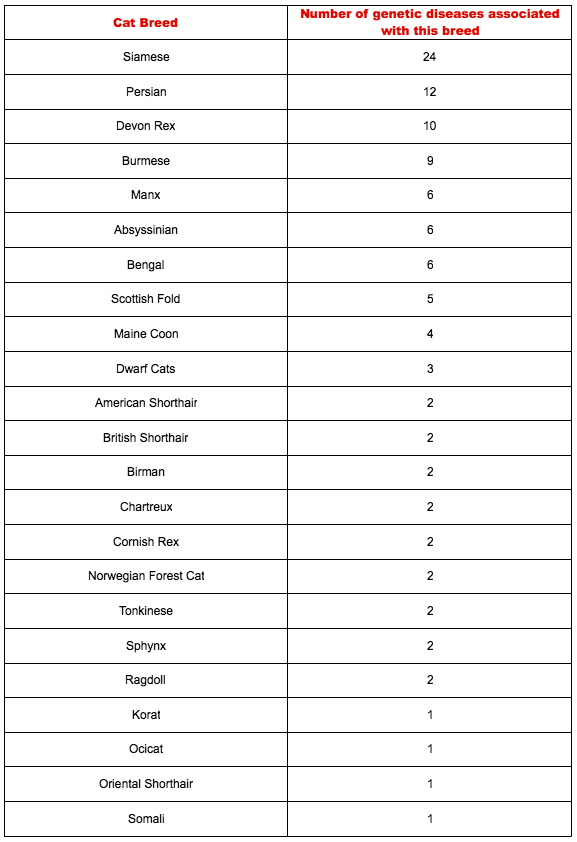Despite its esteemed position as one of the world’s most recognisable and popular purebred cats, the Siamese is arguably the most sick of all the cat breeds, indeed of any other cat.
The title is deliberately provocative but the statement is rooted in fact. Here is a chart that lists the inherited diseases associated with cat breeds. Some cat breeds are not represented on this chart. The reason is that there is, as yet, not enough research on this matter and therefore the information is unavailable. Also some cat breeds have no known inherited diseases.

This is the list of genetic (inherited) diseases associated with the Siamese:
- Asthma
- Cutaneous asthenia – 2 types (a) thin skin, or (b) soft velvety skin that is easily damaged.
- Esophageal hypomotility – spontaneous movement of the intestine. The cat regurgitates, is feverish and has respiratory problems.
- Mast cell tumors
- Hypotrichosis – abnormal hair patterns due to thinning.
- Cutaneous mastocytomas – masses under the skin.
- Glaucoma – chronic open-angled glaucoma – increased eye pressure.
- Cervical neck lesions – bad teeth. Siamese cats need dental checks.
- Hip dysplasia – loose hip joint
- Feline hyperesthesia syndrome
- Feline endocrine alopecia
- Mucopolysaccharidosis
- Gangliosidosis
- Adenocarcinomas of the small intestine
- Malignant mammary tumors
- Numerous congenital heart defects (PDA, aortic stenosis, AV valve Malformation, pyloric stenosis, etc)
- Strabismus – squint – the classic. original cross-eyed cat.
- Primary endocardial fibroelastosis
- Nystagmus – rapid eye movements left to right.
- Congenital heart defects
- Hydrocephalus – kittens have a domed shaped head, abnormal gait, depression, head ache.
- Sphingomyelinosis – retarded growth and ataxia (wobbly gait). Head bobbing. Death before one year of age.
- Chronic Degenerative Keratitis
- Hepatic Amyloidosis
When the Siamese cat was first imported from Siam to England, UK in 1886, Mrs Vyvyan of Dover, England, UK, describes the cat as dominant over other cats in the area where she lived. They were strong cats but they suffered from an acute case of worms. The condition was so bad the cats tried to cough them up. Veterinary surgery was hardly in existence and she gave them chicken heads and feathers for relief. An inauspicious start, health-wise.
The high number of genetic diseases associated with the Siamese has not been explained. For me it is caused by over zealous breeding for appearance while placing health as a secondary consideration.
I am referring to the extreme selective breeding that has created the slender and highly “refined” modern Siamese with the bony, elongated head. All breeders will disagree with me. I am fine with that.
Primary Source: Genetic Diseases in Purebred Cats – Source: Medical, Genetic, & Behavioral Aspects of Purebred Cats; Ross D.Clark, DVM.


Sally, thanks a lot for your comment. If you can see yourself doing it, I’d love it if you could write some more on this topic. Say around 500 words. It would make a useful article. First-hand experience is powerful.
Note: these were all British.
Completely agree. To my (now) shame I had a number of Siamese cats and all died young, pancreatic problems, stomach problems, severe kidney disease, lymphoma, we knew the vet very well. It was heart breaking; each one was special, and I will never forget them. I understand why people love them, they are loving, gregarious and cuddly, but by buying the kittens I was part of the problem, demand and supply.
I am not exaggerating. The list of genetically inherited diseases for this breed is the longest and it comes from a solid source. Sorry but you are wrong. Some breeds should not bred (Manx and Scottish Fold) and I have removed these from the assessment.
I am very disappointed in your over exaggeration of the problems of the siamese, you have chose to show many minor issues that many breeds have themselves, they are not solely meezer issues and are just as prevalent in others.
They have eye problems, breathing and cancer but to say that bsh has only two when you show a meezers minor ones as well is biased.
If you were to include the minor issues of the other breeds it would be Not much of a difference between them. Breeds like bsh have a lot more than two. Maybe two major issues (all though that is false aswell), but then you should only include the three most common and major things for meezers too.
They may look fragile but they can be quite healthy if you screened the parents, which you should with any breed.
Also I am not saying this because I breed them either.